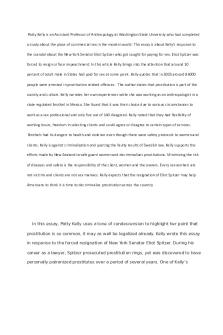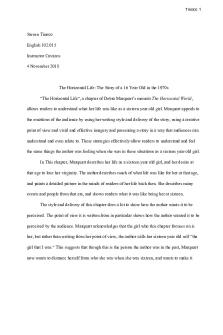Rhetorical Analysis PDF

| Title | Rhetorical Analysis |
|---|---|
| Course | Introduction to Academic Writing |
| Institution | Utah Valley University |
| Pages | 5 |
| File Size | 64.7 KB |
| File Type | |
| Total Downloads | 36 |
| Total Views | 210 |
Summary
Rhetorical Analysis of a film. ...
Description
English 1010 Rhetorical Analysis: Eternal Sunshine of the Spotless Mind Eternal Sunshine of the Spotless Mind is a 2004 American romantic sciencefiction comedy-drama film written by Charlie Kaufman and directed by Michel Gondry. This engaging film portrays both the fragility and complexity of the human mind, creates a fresh never-seen-before romantic storyline that contains a contrast of daily events, which portray the intricacy of love while still making allowance for science fiction factors, and supports a new take on memory’s role in identity, all of which reflect the transition from the ‘90s to the millenium and the ongoing quest to explore the possibilities and limits of altering the human experience through technology. After having his ex-lover erased from his memory the night before, the protagonist Joel (Jim Carrey), finds himself prompted to spontaneously go to a place familiar to him where he meets a girl named Clementine (Kate Winslet) on his way home. As they meet, they recall familiar elements of each other such as gestures and personalities traits. As the film goes on, a set of flashbacks show they shared a relationship in the past that concluded with them having each other erased from their memory. Their second encounter is completely different from the first one but shares the same result, with them falling in love. The experiment that they undergo to erase themselves from their memories shows the fragility and complexity of the human mind. Joel is asked to collect some items from their relationship referred to as “tokens”, used to create a map of her in his brain. After they establish the emotional core to memories, scientists are able to target the trace. A nonlinear technique helps to see their reencounter next to the process of minderasing. When inside of his memories, he fights the process and
tries to protect her memories. There’s a lot of symbolisms as building collapsing, physical structures in memories crumble, and moments are taken out of context. As Joel realizes he wants to keep Clementine in his memory, he starts to fight the process and tries to shield her from the erasing pattern by associating her to memories she doesn’t belong to, such as his childhood, a place in his brain that surely won’t be targeted during the procedure. Events that are taken out of context next to elements such as slow motion, repetition and deformation of shapes, narrate the procedure of deleting the memory of Clementine out of Joel’s mind. The journey accompanied by very subtle and light music with simple instruments, makes for an emotional ride. Even though the process succeeds and is completed, the day after he finds himself prompted to go to the place they first met, that prompt is shared between both of them. They share a ride home where he’s able to paint her, who seems to be a complete stranger to him, in extreme detail. The map they traced in Joel’s mind to erase Clementine didn’t seem to take into account other elements that compose the human brain such as the subconscious, where they’re able to save small parts of each other. In a plot twist, one of the scientists tries to date Clementine and duplicate exactly the moments she and Joel had together. To his surprise, her reaction to them is completely different, proving once again how complex the human mind is. Her association is also different than Joel’s, she finds herself associating hair colors to emotions and mind states, in contrast to Joel who finds out things and nature elements, such as water to be his biggest triggers. As they reminisce on their relationship, everyday relationship’s situations meet science fiction elements within the movie. Joel and Clementine’s relationship is shown through fast motion sequences that are abundant in fights, disagreements
and routine. These scenes make for one of the most realistic yet fictional romantics films ever created. Clementine discovers through glances of the past and vivid sequences, her part of the blame and is able to reflect on her role in their relationship. Joel embarcs in a self-discovering journey that traces back to his adolescence, where he finds unsolved trauma that along with black and white scenes and nostalgic music will be the key to realizing his part in the failed relationship. This shows yet again the fragility of it all, they had to go into this selfexploring journey to recognize situations that would be obvious to an outsider, but to them were not as clear. Thanks to flash forwarding and framing, viewers are able to feel part of the journey that concludes in the realization that love is imperfect, just as humans are imperfect. The flaws and struggles of a relationship is what makes it so real and relatable but yet fantastic. A new take on memory and life is introduced. As proposed by The Philosophy.com blog, against most philosophers who considered the memory as the foundation of identity and thus the stability of the individual, Eternal Sunshine supports to the Nietzsche’s thesis that forgetting is vital to humans. Memory and thereby the memories it accumulates, weighs above men and paralyze their actions. Amnesia is presented as a lightness, a source of creativity and freedom. Instead, the “hypermnesic” (inability to forget) would be pure retention, pure nostalgia. Outside of time, says Nietzsche, the man pulls his historicity, tastes pure present, conquers and feels his freedom. Through soft lighting and tilting of the camera there’s a high-speed sequence where Joel shares all of the highlights of his life. Trauma and changing moments, such as puberty, are off limits according to the procedure rules of the experiment.
This was an element that made the film as successful as it was when it first premiered, the concept of erasing someone from one’s memory has crossed everyone’s mind at some point. According to the same blog, the idea originated as an art project executed by the writers, which included handing out cards to their friends and relatives that said they were trying to forget someone from their life, and to please never to mention their name to them again, same cards as in the movie. Even though the movie came out in 2004, it takes place in the ‘90s. It marks the transition to a new modern era. The ‘90s is known as a decade of big technological advances, a lot of different kind of experiments were taking place at that time. As scientists were trying to find the limits as to how much technology could do for them, The Eternal Sunshine portrays what it can’t. Human nature and behavior are areas new technology is still trying to find their role in. We would like to have technology fix all our problems, to answer all of our questions but as Joel and Clementine find out by the end of their journey, not every flaw is meant to fixed and not every question is to be answered. As we embark in a modern era where technology seems to be winning the fight versus humanity, this film reminds the essence of humanity, the conquer of the complexity of the human mind above it all. At the end, there wasn’t technology that could alter the process, experiences and we could even say the destiny of the two protagonists, to help reaffirm the idea of the wonders our mind can achieve. The experiment talked about in the movie succeed, they could’ve continue to do that for more people, be more advanced. However, the scientists themselves decide to surrender in their quest for a better control over the human mind, recognizing the best way to honor the complexity of it, it’s not to try to alter it, but to amuse it and respect its complicated processes.
The Eternal Sunshine of the Spotless Mind is the perfect balance between reality and fiction, complexity and fragility. Throughout the film, there’s proof after proof of how perfectly composed our human brain is, a perfection we might don’t even be able to fully comprehend. The idea of having the option of deleting all the painful memories of someone from our mind seems appealing, however they are as vital to our human existence as the good ones. Portrayed using different methods, the film main focus is the essence of the human being. Behavioral and sentimental patterns that we all share and can relate to meet science fiction elements that reaffirm the divinity of it all. Joel and Clementine reach the conclusion that to alter the core of life is to loose the very essence that makes it as wonderful and difficult, as it’s supposed to be. Finally, as quoted in the movie, the purpose of it all can be summarize in this quote by Alexander Pope that goes, “How happy is the blameless vestal's lot! The world forgetting, by the world forgot. Eternal sunshine of the spotless mind! Each pray'r accepted, and each wish resign'd?”....
Similar Free PDFs

Rhetorical Analysis
- 5 Pages

Rhetorical analysis
- 2 Pages

Puppy Rhetorical Analysis
- 4 Pages

Rhetorical analysis -1
- 4 Pages

Bowling Dana Rhetorical Analysis
- 4 Pages

Rhetorical Analysis Essay
- 5 Pages

Textual Rhetorical Analysis
- 3 Pages

Rhetorical Analysis Final
- 5 Pages

Rhetorical Analysis Prompt
- 2 Pages

Final Rhetorical Analysis Essay
- 2 Pages

Rhetorical analysis pt1
- 2 Pages

Rhetorical Analysis - enc2135
- 6 Pages

Rhetorical Analysis Essay
- 4 Pages
Popular Institutions
- Tinajero National High School - Annex
- Politeknik Caltex Riau
- Yokohama City University
- SGT University
- University of Al-Qadisiyah
- Divine Word College of Vigan
- Techniek College Rotterdam
- Universidade de Santiago
- Universiti Teknologi MARA Cawangan Johor Kampus Pasir Gudang
- Poltekkes Kemenkes Yogyakarta
- Baguio City National High School
- Colegio san marcos
- preparatoria uno
- Centro de Bachillerato Tecnológico Industrial y de Servicios No. 107
- Dalian Maritime University
- Quang Trung Secondary School
- Colegio Tecnológico en Informática
- Corporación Regional de Educación Superior
- Grupo CEDVA
- Dar Al Uloom University
- Centro de Estudios Preuniversitarios de la Universidad Nacional de Ingeniería
- 上智大学
- Aakash International School, Nuna Majara
- San Felipe Neri Catholic School
- Kang Chiao International School - New Taipei City
- Misamis Occidental National High School
- Institución Educativa Escuela Normal Juan Ladrilleros
- Kolehiyo ng Pantukan
- Batanes State College
- Instituto Continental
- Sekolah Menengah Kejuruan Kesehatan Kaltara (Tarakan)
- Colegio de La Inmaculada Concepcion - Cebu


